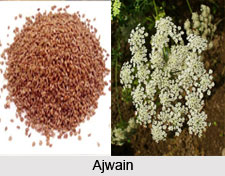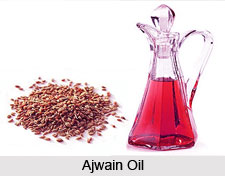 Ajwain is an annual herbaceous plant bearing the greyish- brown fruits [seeds], which constitute the spice. The plant is grown in Iran, Egypt, Afghanistan and chiefly in India, largely in Uttar Pradesh, Bihar, Madhya Pradesh, Punjab, Rajasthan, West Bengal, Tamil Nadu and Andhra Pradesh etc. It is generally grown in October-November and harvested in May-June.
Ajwain is an annual herbaceous plant bearing the greyish- brown fruits [seeds], which constitute the spice. The plant is grown in Iran, Egypt, Afghanistan and chiefly in India, largely in Uttar Pradesh, Bihar, Madhya Pradesh, Punjab, Rajasthan, West Bengal, Tamil Nadu and Andhra Pradesh etc. It is generally grown in October-November and harvested in May-June.
Botanical Name: Trachyspermum ammi [L] Sprague.
Syn: Carum copticum Heirn
Family: Umbelliferae
English Name: Bishop`s Weed
Indian Names are as follows:
Hindi: Ajwain
Bengali: Jowan or Joan
Gujarati: Yavan
Kashmiri: Jawind
Kannada: Oma
Malayalam: Omum
Marathi: Onva
Oriya: Juani
Urdu: Ajowain
Sanskrit: Ajamoda Yavanika
Tamil: Omum
Telugu: Vamu
Ajwain seeds, like other spices, are not viewed nutritionally. They are more known as adjuncts used in small quantities for flavouring numerous foods, as anti-oxidants, as preservatives, or in medicine or for the manufacture of essential oils for ultimate use in perfumery, essences and medicines etc. However, for the purpose of enforcement of quality standards with the ultimate objective of detection of adulteration, information on physic-chemical composition is often sought which in brief, is as follows:
Moisture: 8.9 %
Protein: 15.4 %
Fat: 18.1 %
Crude fibre: 11.9 %
Carbohydrates: 38.6 %
Mineral matter: 7.1 %
Calcium: 1.42 %
Phosphorus: 0.30 %
Iron: 14.6 mg/100g
Calorific value: 379/100g.
Health Benefits of Ajwain
Ajwain can be used in a wide variety of food items. It possesses preservative and medicinal properties. In India it is used with pulses, meat and liver. Ground with ginger and salt, it forms chutney. In the west, it is used for making soups and curries. Ajwain is rich in calcium and iron and is used to enhance digestion. It is an anthelmintic and antiseptic. Ajwain oil is used for treating cholera, stomach pains, diarrhoea and indigestion
Steam distillation of crushed seeds yields 2.5 to 4.0 % essential oil which is valued considerably in medicine on account of the presence of thymol therein. Ajwain seed is distilled in India, partly in primitive native stills and partly in more modern and large-scale distilleries. Prior to and during World War I, considerable quantities of ajwain seed was exported from India for distillation in Europe and the United States. The oil was for a long time the principal source of thymol. However, since the introduction of synthetic thymol, the distillation of ajwain oil outside India has partially ceased, and the oil has lost its former importance. However, the demand situation is fast changing now with more demand for natural goods than synthetic goods. This changing scenario may put India to advantageous position only if India is in a position to meet the demand. We have necessary resource, since India produces sufficient ajwain. We are only to gear up production of ajwain oil with right quantity of thymol so that we shall be in a position to meet expected global demand. The standard technology is available, so also various schemes. We shall only to plan and implement.
 Oil of ajwain is an almost colourless to brownish liquid, which has a characteristic odor and a sharp burning taste. On standing, a part of the thymol may separate from the oil in the form of crystals, which is sold in Indian market under the name of "Ajwain ka Phool" or "Sat Ajwain" and is much valued in medicine, as it has nearly all the properties ascribed to the ajwain seeds. This was used in surgery as an antiseptic and was also found to be of great value in the treatment of hookworm disease. The aqueous solution of thymol is an excellent mouthwash and thymol is a constituent of many toothpastes. Extracts of seeds in 70 % and 40 % alcohol are toxic to Staphylococci and Escherichiacoli. There are a number of medicinal virtues this spice has and is considered as an important herb in case of Indian systems of medicine. Therefore there is possibility of using this source for planning projects for manufacture of various medicinal preparations.
Oil of ajwain is an almost colourless to brownish liquid, which has a characteristic odor and a sharp burning taste. On standing, a part of the thymol may separate from the oil in the form of crystals, which is sold in Indian market under the name of "Ajwain ka Phool" or "Sat Ajwain" and is much valued in medicine, as it has nearly all the properties ascribed to the ajwain seeds. This was used in surgery as an antiseptic and was also found to be of great value in the treatment of hookworm disease. The aqueous solution of thymol is an excellent mouthwash and thymol is a constituent of many toothpastes. Extracts of seeds in 70 % and 40 % alcohol are toxic to Staphylococci and Escherichiacoli. There are a number of medicinal virtues this spice has and is considered as an important herb in case of Indian systems of medicine. Therefore there is possibility of using this source for planning projects for manufacture of various medicinal preparations.




















